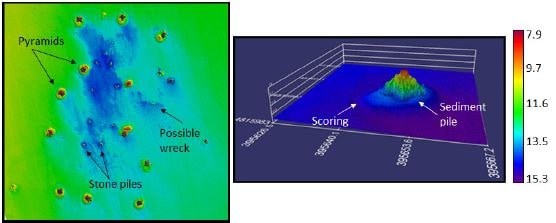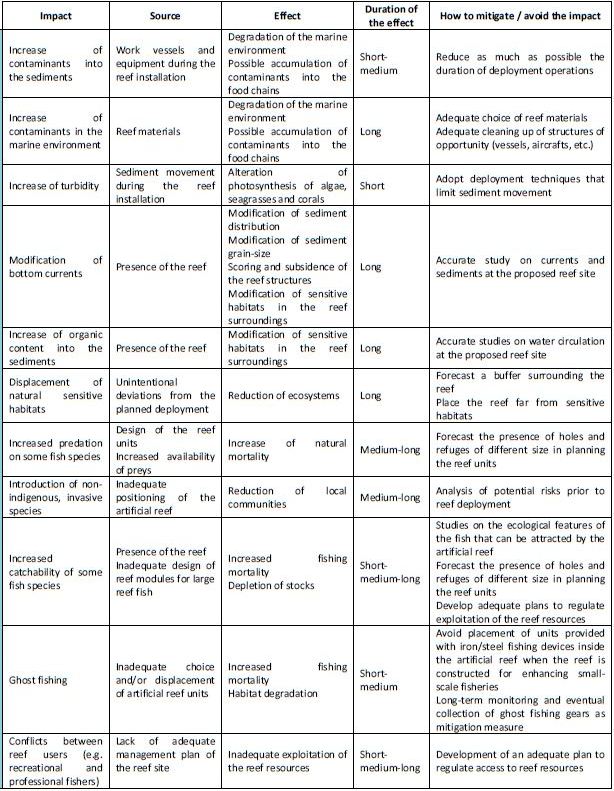6 Possible negative impacts
Artificial reef deployment may have negative impacts on the environment, either during the construction or once the reef has been established. These potential negative impacts should be considered in reef planning.
During the installation of an artificial reef, the presence of work vessels and other mechanical equipment can lead to the release in the environment of pollutants that might accumulate in the sediments. Moreover, the immersion of artificial substrates may induce a short?term increase of turbidity due to sediment disturbance, hence temporarily altering photosynthesis of algae, seagrasses and corals. Sediments suspended during the construction can also settle in surrounding habitats, where they may smother existing communities. The extent of the impacts will depend on the volume of the sediments disturbed and on local currents.
Once an artificial reef has been deployed, there may be some long?term environmental changes. These may be a modification of bottom currents leading to subsequent variations in the grain size distribution and possible localized sediment scour close to reef modules (Fig. 19). An additional effect may be a change in sediment organic content due to the metabolic activity of benthic and fish assemblages associated to the reef. These effects are likely to modify the original soft?bottom community inhabiting the surroundings. Such modifications can be either positive or negative. For example, a production artificial reef deployed on a seabed habitat that is degraded by organic polluted sediments can induce the development of a new, more productive, biological community. On the other hand, if the same artificial units are placed on Posidonia or maerl beds, the new benthic communities associated to the artificial reef can cause negative impacts on the original sensitive habitats.

Figure 19. Adriatic Sea: acoustic images of an artificial reef showing the modification of sediment distribution induced by the artificial substrates. The strong current has eroded the sea bottom at the south of the reef sets (violet area) raising each of them on a sediment pile
(courtesy of CNR?ISMAR Ancona).
Artificial reefs may also cause negative impacts on fish resources, especially when reefs modify the spatial redistribution of exploitable biomass by simply aggregating it without increasing the total stock. This is the case of C?type C and D?type fish (see Section 5.2.2). In the absence of adequate management measures, a higher density at the reef increases the probability for this fish to be caught. Greater accessibility to the resources increases the potential fishing effort, leading to an increase of fishing mortality and, consequently, a decrease of the exploitable biomass in the area (Polovina, 1991).
Possible negative effects on the fish species inhabiting an artificial reef may derive from the ghost fishing generated by the entrapment of set nets on the artificial substrates and consequent loss of the gears. These nets will continue fishing for a certain time and entangled fish which die and rot may cause a degradation of the reef environment.
A further concern regards the potential contribution of artificial reefs to the introduction and expansion of non?indigenous species, including parasites, as the artificial reefs may provide these invasive species with a suitable habitat which previously did not exist. Artificial reefs may also provide connectivity between areas where invasive species are present and areas where their occurrence has not been documented. A risk analysis should be performed prior to the deployment of an artificial reef in order to evaluate the vulnerability of the designed reef site towards invasive non?indigenous species, in terms of known outbreaks and occurrence of invasive species in regions close or adjacent to the proposed reef sites.
From a socio?economic point of view, in the absence of an adequate management plan that regulates the access and catch rates at the reef, the deployment of an artificial reef might increase conflicts between the potential users of the reef and cause an overexploitation of the reef resources.
Table 2 reports a list of the possible negative impacts generated by artificial reef deployment. Most of these impacts can be mitigated or avoided thanks to careful planning, appropriate site selection and construction materials, and a correct reef design taking into account both the purpose of the reef and the oceanographic conditions at the proposed site.
Table 2: List of possible negative impacts of artificial reefs and actions to be undertaken to avoid or mitigate such impacts


Given that most artificial reefs will have a design life in excess of 30 years, the long?term management of the reef should be considered carefully during the planning phase. Ownership, responsibility and liability need to be considered, and possible mitigation actions forecasted. In the short term, careful planning during the installation phase of the reef should mitigate a majority of concerns aligned with construction (increased turbidity, pollution for installation plant and equipment, etc.).